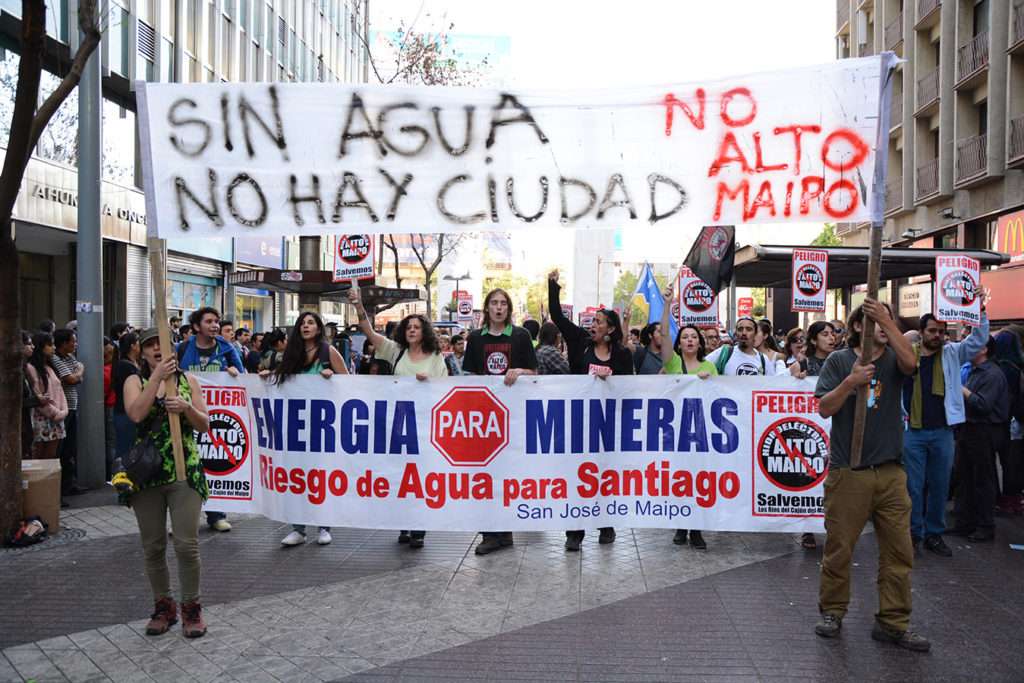By Leyla Balimtas, Communications Intern
The Alto Maipo Hydroelectric Project, currently under construction just outside Santiago, Chile, threatens the water supply for over 7 million Chileans, and will have long-term devastating environmental impacts. Concerned citizens call the project “unviable” and are calling for it to be halted.
As Marcela Mella met with World Bank representatives in Washington DC in January, her attention was torn. While the meetings in DC were a crucial step in holding both the International Finance Institution (IFC – the private lending arm of the World Bank) and the Inter-American Development Bank accountable for their reckless investment in the Alto Maipo hydroelectric project, Marcela’s town was on fire.
Chilean Wildfires
Dozens of wildfires, exacerbated by a “mega-drought” of above average temperatures and a decades’ worth of rain shortages, were tearing through Chile in a disaster so severe it has been compared to the massive 2009 wildfires in Australia, one of the worst bush wildfires in recorded history. But while Australia is accustomed to fire as an integral part of its dynamic ecosystem – a cycle as natural as rain, the ecosystems of central Chile are not adapted to fires and are incredibly vulnerable.
Glacial Melting
Beyond the severe drought and wildfires, rising temperatures from climate change have also caused rapid glacial melt throughout the country. Chile is home to more than 24,000 glaciers – representing 82% of all glaciers in South America. These slow-moving masses or rivers of ice formed by accumulating and compacting snow make up one of the world’s largest freshwater reserves and supply water to millions of Chileans.
Over the past 40 years, mean temperatures in central Chile have increased by nearly 1ºC, causing thousands of glaciers to melt faster than anywhere else in the world. These observed rising temperatures have already caused nearly 50% of the Andean cryosphere (frozen water part of the Earth system) to disappear, which has led to a drastic increase in water discharge. However, with mean temperatures projected to increase by an additional 1ºC over the next 25 years and 3ºC by the year 2100, water discharge from glacial melt will ultimately decrease, threatening both river flow and the availability of drinking water.
Glaciers also provide the most important source of replenishment for rivers, lakes, and groundwater in arid regions during periods of drought. Chilean glaciers are the source of the Colorado, Yeso and El Volcán Rivers, each of which converge to form the Maipo River. These tributaries constitute 60% of the drinking water for the residents of Santiago and irrigate more than 120,000 hectares of farmland.
Alto Maipo’s Energy Implications
The Alto Maipo Hydroelectric Project (PHAM for its initials in Spanish), a large-scale hydroelectric project currently under construction outside of Santiago, Chile, will generate its energy by forcing the Maipo River through a series of tunnels. If completed, the PHAM will be comprised of two underground power stations and 67 km of tunnels, created partly by drilling and blasting and partly by a tunnel-boring machine. While the project will capable of generating a total output of 531MW of electricity, the harnessed energy will directly benefit mining interests, instead of the local electrical grid.
The project’s diversion of the Maipo River through tunnel blasting will not only disrupt surrounding glaciers, but also deprive the river of its natural flow. This has the potential to desertify 100,000 hectares of the Maipo River basin and significantly depreciate the water supply to millions of Chilean citizens, further exacerbating and escalating the impacts of the already-threatened Maipo watershed.
Depletion of Ecosystem Services
Rapid glacial melt has also caused changes in availability and seasonal distribution of water flows, resulting in an increase the number of hydrologic deficit months in Chilean river basins and the quality of that water. Months of low water flow can decrease ecosystem services of surface and groundwater, which prevents water systems from properly diluting and regulating pollutants and liquid waste emissions.
A decrease in ecosystem services also has the potential to cause irreparable damage to sensitive Chilean environments and species. And with the Maipo River basin home to the Glacial Natural Monument, two Nature Sanctuaries, and other protected wildlife areas, thousands of endemic species and unique fauna could be at risk of significant harm.
The Future of Alto Maipo
Not only will the PHAM exacerbate already-threatened Chilean environments, but the project will also jeopardize several human rights, including the right to water, the right to live in a healthy environment, and the right to develop sustainable economic activities. It is for these reasons that the No Alto Maipo Citizens’ Coalition, together with CIEL’s support, are calling for two of the major financing development banks to withdraw their ill-advised investments in this dangerous project.

Originally posted April 12, 2017
